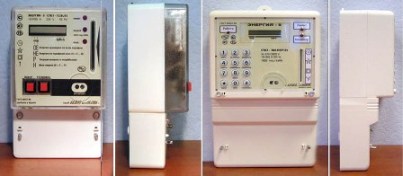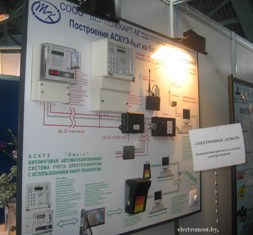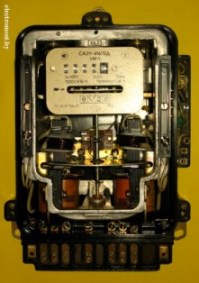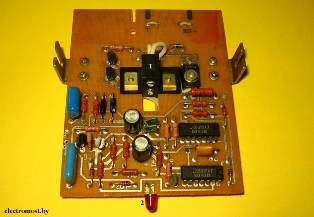Categories: Sharing experience, Interesting electrical news
Number of views: 357135
Comments on the article: 12
About electronic meters and ASKUE for "dummies"
Electronic meters
An electronic counter is a converter of an analog signal to a pulse repetition rate, the calculation of which gives the amount of energy consumed.
The main advantage of electronic meters compared to induction ones is the absence of rotating elements. In addition, they provide a wider range of input voltages, make it easy to organize multi-tariff metering systems, and have a retrospective mode - i.e. allow you to see the amount of energy consumed for a certain period - usually monthly; measure power consumption, easily fit into the configuration ASKUE systems and have many more additional service functions.
A variety of these features lies in the software. microcontroller, which is an indispensable attribute of a modern electronic electricity meter.
Constructively electric meter the meter consists of a housing with terminal block, a current measuring transformer and a printed circuit board on which all electronic components are installed.

The main components of a modern electronic meter are: current transformer, LCD display, electronic circuit power supply, microcontroller, real-time clock, telemetric output, supervisor, controls, optical port (optional).
The LCD is a multi-digit alphanumeric indicator and is intended to indicate operating modes, information about the consumed electricity, display the date and current time.
The power source is used to obtain the supply voltage of the microcontroller and other elements of the electronic circuit. A supervisor is associated directly with the source. The supervisor generates a reset signal for the microcontroller when the power is turned on and off, and also monitors changes in the input voltage.
The real-time clock is designed to count the current time and date. In some electric meters, these functions are assigned to the microcontroller, however, to reduce its load, as a rule, they use a separate chip, for example, DS1307N. Using a separate chip allows you to free up the power of the microcontroller and direct them to more demanding tasks.
The telemetric output is used to connect to the ASKUE system or directly to the computer (as a rule, through the RS485 / RS232 interface converter). The optical port, which is not available in all electric meters, allows you to take information directly from the electric meter and, in some cases, serves for their programming (parameterization).
The heart of the electronic meter is a microcontroller. It could be like Microchip chip (PIC controller), as well as manufacturers of ATMEL or NEC.
In an electronic meter, the performance of almost all functions is assigned to the microcontroller. It is an ADC converter (converts the input signal from the current transformer into a digital form, performs its mathematical processing and outputs the result to a digital display.) The microcontroller also receives commands from the controls and controls the interface outputs.
The capabilities that the microcontroller possesses, I repeat, depend on its software (software). Without software - it's just a plastic - silicon cube smile. Therefore, the variety of service functions and tasks performed depends on what technical task was set for the programmer.
Currently, the development of electronic meters is mainly in terms of adding “bells and whistles”, various manufacturers are adding new functions, for example, some devices can monitor the status of the power supply network with the transmission of this information to dispatch centers, etc.
Quite often, a power limitation function is introduced into the electric meter. In this case, when the power consumption is exceeded, the electric meter disconnects the consumer from the network. To control the supply of voltage, inside the electric meter is installed contactor to the appropriate current. Shutdown is also possible if the consumer has exceeded the allotted electricity limit or the prepayment for electricity has ended. By the way, some electric meters allow you to replenish the cash balance directly through the built-in plastic card readers. The electric meters of this group include STK-1-10 and STK-3-10, manufactured in Odessa.

ASKUE
Attempts to create an ASKUE (automated control system for electricity metering) are associated with the appearance of relatively affordable microprocessor devices, however, the high cost of the latter made accounting systems accessible only to large industrial enterprises. The development of ASKUE was carried out by whole research institutes.
The solution to the problem involved:
-
equipping induction electric energy meters with revolution sensors;
-
creation of devices capable of counting incoming pulses and transmitting the result to a computer;
-
accumulation in computer of the results of counting and the formation of reporting documents.
The first accounting systems were extremely expensive, unreliable and uninformative complexes, but they allowed to form the basis for the creation of ASKUE next generations.
The turning point in the development of ASKUE was the emergence of personal computers and the creation of electronic electricity meters. The widespread introduction of cellular communications gave an even greater impetus to the development of automated metering systems, which made it possible to create wireless systems, since the issue of organizing communication channels was one of the main in this direction.
The main purpose of the ASKUE system is to collect all data on electric energy flows at all voltage levels in reasonable time intervals and process the data in such a way as to provide reports on consumed or discharged electricity (power), analyze and construct forecasts for consumption (generation) ), perform an analysis of cost indicators and, finally, - most importantly - make calculations for electric energy.
To organize the ASKUE system it is necessary:
-
At the energy metering points, install high-precision metering devices - electronic meters
-
Digital signals to transmit in the so-called "adders", equipped with memory.
-
Create a communication system (as a rule, recently they use GSM - communication for this), which provides further information transfer to local (at the enterprise) and to the upper levels.
-
To organize and equip information processing centers with modern computers and software.

ASKUE scheme
An example of a simple ASKUE organization scheme is shown in the figure. It can distinguish several separate main levels:
1. Level one is the level of information collection.
Elements of this level are electric meters and various devices that measure the parameters of the system. As such devices, various sensors can be used, both having an output for connecting the RS-485 interface, and sensors connected to the system through special analog-to-digital converters. It is necessary to pay attention to the fact that it is possible to use not only electronic electric meters, but also conventional induction meters equipped with converters of the number of revolutions of the disk into electrical pulses.
In ASKUE systems, the RS-485 interface is used to connect sensors to controllers.The input impedance of the information signal receiver via the RS-485 interface is usually 12 kOhm. Since the transmitter power is limited, this also limits the number of receivers connected to the line. According to the specification of the RS-485 interface, taking into account the terminating resistors, the receiver can conduct up to 32 sensors.
2. The second level is the connecting level.
At this level are the various controllers needed to transport the signal. In the ASKUE scheme shown in Figure 9, the second-level element is a converter that converts the electronic signal from the RS-485 interface line to the RS-232 interface line, this is necessary for data reading by a computer or by a control controller.
If it is necessary to connect more than 32 sensors, then devices called hubs appear in the circuit at this level. The figure shows the construction scheme of the ASKUE system for the number of sensors from 1 to 247 pcs.

The third level is the level of data collection, analysis and storage. An element of this level is a computer, controller, or server. The main requirement for equipment at this level is the availability of specialized software to configure system elements.
Currently, almost all electronic electricity meters are equipped with an interface for inclusion in the ASKUE system. Even those that do not have this feature can be equipped with an optical port for local taking readings directly at the installation site of the meter by reading information into a personal computer. Therefore, today the electric meter is a complex electronic device.
However, you should not think that only electronic meters can be used for remote reading (namely, this goal is the main one in ASKUE systems).
Meters marked with the letter “D”, for example, SR3U-I670D, have a telemetric output (pulse sensor), which ensures the transmission of information about active (reactive) energy passing through the meter to the remote data collection and processing system via a two-wire communication line. The figure just shows such an electricity meter with the housing cover removed:

Electric meter SR3U-I670D
A pulse sensor (2) is installed on the side panel of the electric meter. How does this sensor work?
Let's remember the device of the induction meter. It has such an element as an aluminum disk. Its rotation speed is directly proportional to the power consumed by the load. Here is the disk rotation speed, or rather the number of revolutions, and is a numerical characteristic that can be converted into pulses and transmitted to the communication line. Therefore, counters with built-in sensors cause such a parameter as the number of pulses per 1 kW * h.
A measuring transformer serves as a pulse source, the magnetic flux of which periodically crosses the metal sector, mounted on the axis of the disk. The pulses received from it are supplied to the circuit of the sensor itself, and then to the communication line. The sensor receives power on the same line.
In principle, any induction meter can be equipped with a pulse sensor, for example, such as the E870.

Pulse Sensor E870
The principle of operation of the E870 sensor is different from that described above. For its functioning, a darkened sector is applied with black paint to the flat surface of the meter’s disk.
The pulse sensor - converter has a photo-LED head in its design - i.e. a couple photodiode - LED. The sensor is installed inside the counter so that the head is directed towards the disk. The signal emitted by the LED is reflected from the disk and received by the photodiode. Due to the darkened sector of the disk, the signal is intermittent.
The electronic circuit on the logic elements monitors these interruptions, converts and issues consecutive pulses to the communication line.The duty cycle (repetition rate) of these pulses is directly proportional to the speed of rotation of the disk, and, therefore, the power consumption and it can be visually assessed by the indicator LED.
On the other side of the communication line, the receiving device receives these pulses, counts their number for a certain period of time, and provides the result to the information display device. Thus, the meter reads remotely. This is how the first systems of remote information collection were built.
However, a legitimate question arises - above we examined the RS 485 and RS 232 interfaces, but here we have a sequence of pulses.
It turns out, all the same, we will not link induction counters into the modern schemes for building an automated power metering and accounting system considered above? In principle, this can be done. Converting a pulse sequence into the same RS 232 interface is not difficult, this adapter will be a relatively simple electronic circuit. But there isn’t much point in this. Induction electric meters are gradually becoming a thing of the past, and where they are installed, they are used only as local metering devices.
When designing modern ASKUE systems, only electronic meters are used. They have undeniable advantages over induction in the “information” plan and have almost unlimited service capabilities.
Mikhail Tikhonchuk
Read also on this topic:How is the electronic electricity meter arranged and working
See also at bgv.electricianexp.com
:
